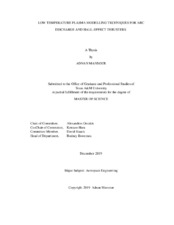| dc.description.abstract | The growth of plasma applications in industrial and scientific settings has led to the
need for consistent computational plasma models. The multi-scale, highly nonlinear physics
involved in plasma processes creates a challenging environment for computational modelling.
Different combinations of assumptions and approximations are utilized to ease the
computational burden associated with plasma fluid models.
The goal of this research work is to document and describe in detail the theory, numerical
modelling and results of two separate projects in plasma modelling. The first project is
a multi-species one-dimensional model of ablating carbon arc discharge, namely for the
synthesis of carbon nanotubes. It focuses on the development of chemical and physical
models, as well as the derivation of multiple governing equations and boundary conditions
used. Governing equations are solved for eleven species, and the chemical composition of the
arc is dynamically updated. Multiple parameters are varied and benchmarked against each
other. Numerical results are presented from published work and compared to experimental
results, with which they have shown good agreement.
The second project describes the development of numerical methods for a one-dimensional
non-neutral drift-diffusion plasma model for Hall-effect thrusters. The overarching purpose
of the project is to investigate the anomalous electron transport observed in experiments, yet
to be captured by numerical models, by removing general assumptions one step at a time.
The end goal is to have a simulation that does not rely on artificially introducing the empirical
anomalous transport coefficient to achieve levels of electron mobility observed in experimental
setups. This project removes the quasi-neutral assumption and solves for the electrons
as a separate species, utilizing the drift-diffusion model. It focuses on the implementation
of several numerical schemes that are developed to help alleviate the severe timestep size
restrictions associated with non-neutral plasma models. Results are compared with results
from neutral simulations as well as other non-neutral models in development. | en |


